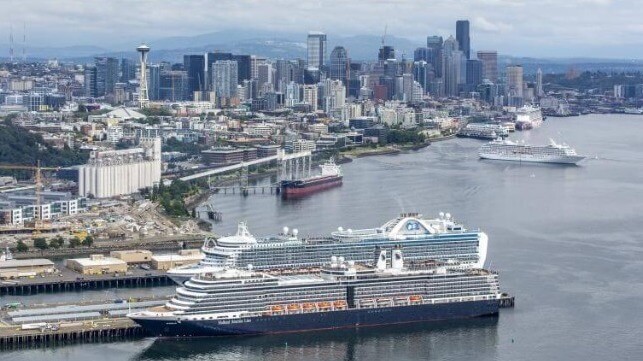Ports and Cruise Lines Explore Pacific Northwest-Alaska Green Corridor

Ports ranging from Seattle and Vancouver to Juneau, Alaska which make up one of the most densely operated cruise routes announced plans to work with the cruise industry to explore one of the first green corridors for shipping. Calling their effort The First Mover Commitment, the three ports, three major cruise corporations, and the cruise industry trade association supported by three maritime forums announced their effort to explore the feasibly of the world’s first cruise-led green shipping corridor.
The collaborative effort is aimed at exploring the feasibility of a green corridor that could accelerate the deployment of zero greenhouse gas emission ships and operations between Alaska, British Columbia, and Washington. The organizers highlighted that Alaska hosts more than 600 cruise sailings per year, with nearly 300 ships departing Seattle for Alaska in a six-month cruise season. While the effort is being led in collaboration with the cruise industry, this initiative said it would welcome participation from all sectors of the maritime industry and other regional ports. Domestic cargo lines, ferries, commercial fishing, tug, and barges, and other ports have a strong interest and shared goals around climate action and they would welcome an expanded agreement to reflect new participants or corridors in the region.
The concept for green corridors that would demonstrate and support the development of zero greenhouse gas emission solutions was advanced at the COP26 conference in Glasgow in November 2021 when 24 countries, including the United States and Canada, signed the Clydebank Declaration committing to supporting the establishment of at least six green corridors by 2025. The premise is that through collaboration across sectors the organizations as leaders will create the technological, economic, and regulatory feasibility needed for zero greenhouse gas emission ships to succeed.
“As maritime routes that showcase low- and zero-emission lifecycle fuels and technologies, Green Shipping Corridors offer a pathway for the collaborations needed to achieve the critical projects and actions for accelerating innovations to achieve zero greenhouse gas emissions,” said Jennifer States, Vice President of Strategies and Projects for Washington Maritime Blue, one of the organizations supporting the initiative. “Cruise vessels and the associated charging/fueling infrastructure can provide key demonstrations for new technologies, paving the way for additional vessel types and broader collaborations.”
First Mover partners include the Port of Seattle, City and Borough of Juneau, Vancouver Fraser Port Authority, along with Carnival Corporation, Norwegian Cruise Line Holdings, Royal Caribbean Group, and Cruise Lines International Association, with the support of the Global Maritime Forum, Blue Sky Maritime Coalition, and Washington Maritime Blue. They will seek to leverage and support each other’s decarbonization work already underway and bring those resources and technological advancements to this effort.
They agreed to work together to explore the feasibility of a green corridor in the Pacific Northwest while enhancing and supporting the emission-reduction efforts already underway. The group will work collaboratively to define the governance structures, terms, and frameworks needed to guide this regional effort and look to use the green corridor as a testbed for low and zero greenhouse gas technologies and ships.
“These first movers are coming together around the need to address the most pressing issue of our time — climate change,” said Port of Seattle Commissioner Fred Felleman. “By exploring the development of a Green Corridor, we’re bringing resources and technological advancements to this region where commercially viable zero greenhouse gas emissions ships may sail that much sooner. We’re not naïve about the challenges ahead. But we recognize the urgency to act as we transition to an inclusive blue economy that works for the climate, commerce, and communities alike.”
This new initiative in the Pacific Northwest joins other previously announced efforts. Shanghai and Los Angeles announced plans for the world’s first corridor and since then other initiatives have been launched around Singapore as well as by the ports of the Baltic and Northern Europe. The cruise liens follow another industry group, the Australian miners and bulk shipping companies which committed to exploring an Australia to Asia corridor.
The signatories to the declaration at COP26 pledged to support the creation of at least half a dozen green corridors by the middle of the decade. Their ambition is to scale up and expand the scope of the initiative by 2030.
